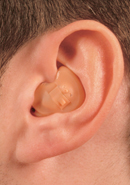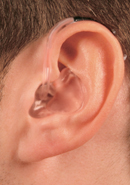Hearing Aids
Which brand and style of hearing aids are best for me?
Hearing Services of Delaware is an independently owned and operated private hearing health care practice. What that means for you is that our hearing care experts have the ability to work with all of the major hearing technology manufacturers to provide you with all of the options to best fit your hearing needs and budget!
All hearing aids contain very similar parts that perform millions of calculations per second. Hearing aids are not “like” little computers, they are little computers! The design and comfortable fit of hearing aids today comes in various styles, sizes, and yes, colors. Some are discreet enough to fit inside your ear canal, making them almost completely invisible. At Hearing Services of Delaware, we believe that knowing more about the solutions and options that are available to help you hear the best you can are more important than how they will look.
Over the past few years, the overall design and performance of hearing aids has improved significantly. The overall physical design of hearing aids today are also more attractive, stylish and allow people to reengage in various activities as well as simply enjoy better hearing in the situations and environments that matter the most to them.
When selecting a style the following is considered:
We will fit devices with adequate amplification for your current hearing loss and for the next few years. We will also determine, with you, the style and level of technology that is best for your listening needs and budget.
- The degree of the hearing loss (power requirements)
- Manual dexterity & visual abilities
- Cosmetics
- Skin sensitivities
- Anatomical/medical considerations
Styles of Hearing Aids
There are a few main considerations when determining the right style of hearing aids. How a hearing aid looks is often times an important part of the selection process however one of the most important item to always keep in mind is that it is not the style or brand of technology you choose – it’s the provider!
In-the-Ear Styles
Hearing aids worn in the ear are usually custom-fit, based on a cast or impression of the ear. They’re available in different skin tones to camouflage with the outer ear. There are several styles – each is listed below, ranging from smallest to largest.

Invisible In-The-Canal (IIC)
The smallest custom style, IIC instruments sit invisibly in or past the second bend of the ear canal. IIC are specifically designed for mild to moderate hearing loss.

Completely-in-the-Canal (CIC)
The smallest custom style, CIC instruments fit deeply and entirely within the ear canal. They fit mild to moderate hearing losses and offer high cosmetic appeal as they’re nearly invisible when worn.

In-the-Canal (ITC)
ITC instruments sit in the lower portion of the outer ear bowl, making them comfortable and easy to use. Because they’re slightly larger than CIC models, they have a longer battery life, and can host additional features such as directional microphones for better understanding in noisy environments, and controls such as volume controls. They fit mild and moderate hearing losses.

Full Shell or In-the-Ear (ITE)
Full shell models sit flush within the outer ear bowl. Their size allows the maximum number of additional controls and features such as directional microphones, which require space on the outer portion of the instrument. They use a larger battery size than the smaller styles, and can fit a larger receiver with enough power for even some severe hearing losses. Because of their flexibility, they’re widely recommended for mild to severe hearing loss.
Behind-the-Ear Styles
Behind-the-Ear (BTE) models sit behind or on top of the outer ear, with tubing that routes sounds down into the ear that connects to an ear tip or earmold to secure them in the ear canal. BTEs come in colors to blend with hair or skin tones, and even chrome colors, leopard print and other funky designs to suit personal styles. Different BTE sizes accommodate different features, controls, battery types and degrees of power (larger instruments generally have more power than smaller ones). While many people choose discreet BTEs that are unnoticeable when worn, others are tempted to show off the cool designs.

Mini BTE with slim tube and tip
Mini BTEs are designed to hide behind the outer ear, and have ultra-thin tubing to discreetly route sound into the ear. The tubing connects to a soft tip that sits in the ear canal but doesn’t occlude it. The result is a natural, open feeling as airflow and sound enter the ear naturally around the tip, while amplified sound enters through the tip. This is known as “open fitting” and is recommended for mild to moderate high frequency losses.

Receiver in the ear (RITE)
RITE models, also known as RIC (receiver-in-canal) models, are mini BTEs that have the speaker of the instrument incorporated in the ear tip, instead of in the main body of the instrument. RITE instruments fit mild to severe hearing losses. This hearing aid style looks similar to the Mini BTE when worn on the ear.

BTE with earmold
BTEs with earmolds fit mild through profound hearing losses. Their longer shape follows the contour behind the outer ear and can house many features such as a program button and volume control. The earmold color and style, as well as the wearer’s hairstyle, determine exactly how they’ll look on each person.
